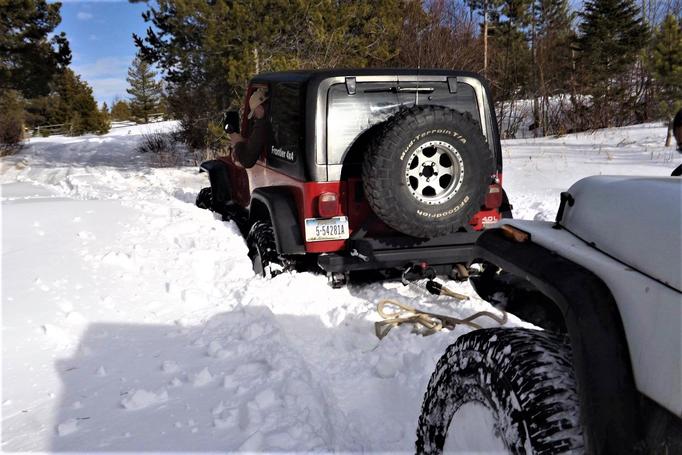OFF-ROADING 101:
Kinetic Rope
|
 |
| Daryl & Joe |
|
|
A LITTLE LESS SHOCK...A LITTLE MORE Ahhhhhhh!
Over the course of hundreds of 4x4 outings, one tends to get the feel for certain tools and accessories that make the tough times better and stand out among the clutter. One of these accessories I have come to be a great fan of is the kinetic energy recovery rope.
This review is speaking from my personal experience as well as that of a good number of friends and fellow off-roaders who have all become staunch converts to kinetic recovery ropes over the years.
I have read many articles pro and con on these verses the standard nylon “snatch strap” and there are, in my opinion, some strange reasoning, at times, for one side or the other. For instance, one reviewer claimed kinetic ropes should be avoided because they take up too much space. Makes one wonder what he was driving. I can’t believe the argument over a rope taking more space than a strap. Oh, it is true, but using up a few more inches of space to have a FAR superior tool seems an easy trade-off. A tool that does less damage to vehicles and occupants while providing more effective recoveries just seems such an easy choice.
NOTE: There are times when ropes are not particularly well suited for the job. Towing on the pavement, in a general sense, is a poor use as they do not hold up well to the kind of abrasion common to that task. Pavement will eat a kinetic rope in short order. However, for snatching a snowbound rig out of a hole, they are just what the doctor ordered.
The only real downside I see in converting to a kinetic rope is the considerable cost difference. My 30' x 4", 30,000-pound recovery strap cost me $19.00 (on sale at Murdochs Ranch Supply) but is generally around $45.00. My 30' x 1” kinetic rope by Master Pull costs about $175.00 currently but is rated at 33,500 pounds. Many snatch straps have just a little stretch with some of the better ones having only around 10% to 15% stretch. On the other hand, most kinetic recovery ropes have around 30%+ stretch and create a substantially higher amount of stored energy.
I have certainly been pulled out of a lot of holes with a standard nylon recovery strap. It, as we all know, works. It is great in those situations where the recovery vehicle has solid ground, good traction, and the stuck rig is not really all that stuck. Then you just take up the slack slowly and use brute strength and traction or hopefully “small” tugs to pull the stuck rig out. The truth is, such perfect conditions seldom happen when wheeling in conditions where a good “stuck” occurs. It is more often that the recovery rig, also on loose ground, mud, or snow, has to back up and gets a running start. The tow rig is effectively smashing against the seemingly solid strap (trust me, it WILL feel that way) when the slack is gone using the momentum of the recovery rig to violently YANK the stuck rig lose. Both rigs and their occupants are subjected to what is essentially a crash-like impact and shock. Most of us know we had better have our teeth, hats, glasses, and such on/in securely or we are going to lose them when the SHOCK of using a standard strap occurs in such conditions.
On the other hand, in those times when one rig is quite stuck and there is poor traction for the recovery rig to use, this is the perfect time for a kinetic rope. With a properly rated kinetic rope, you can use the much more substantive “rubber band effect” of a kinetic rope to do most of the work for you with a lot less shock to all involved. This does a number of things. The “impact” of a standard nylon snatch strap does not really exist with a kinetic rope when used properly. Not only do you not get practically yanked out of your seat but your vehicle does not receive that metal bending and teeth loosening YANK either.
If the recovery vehicle is on a loose surface, such as snow, the recovery vehicle can build up a bit more speed to stretch the rope and then just let off the gas or even hit the brakes after you have stretched the rope and thereby built up substantial kinetic energy. The kinetic energy of up to 30% stretch will often pull a stuck vehicle right out and the recovery vehicle does not need to spin a wheel to do the job. Not spinning your wheels in the snow is often the difference between performing a recovery and ending up needing to be recovered yourself.
Overall, I have found the use of a kinetic rope to be far superior at getting rigs un-stuck, in many circumstances. Doing it with less damage to both vehicles and their drivers is an equally important benefit. Among our group of snow-wheelers here in Helena Montana, it is common for new people to become instant converts to the benefits of Kinetic ropes when pulled out just once. If you get the chance to try a kinetic rope this winter, do so. Odds are, you too will become an instant convert to the benefits of kinetic energy recovery ropes.
Opinion By: Richard Hiltz
|
|